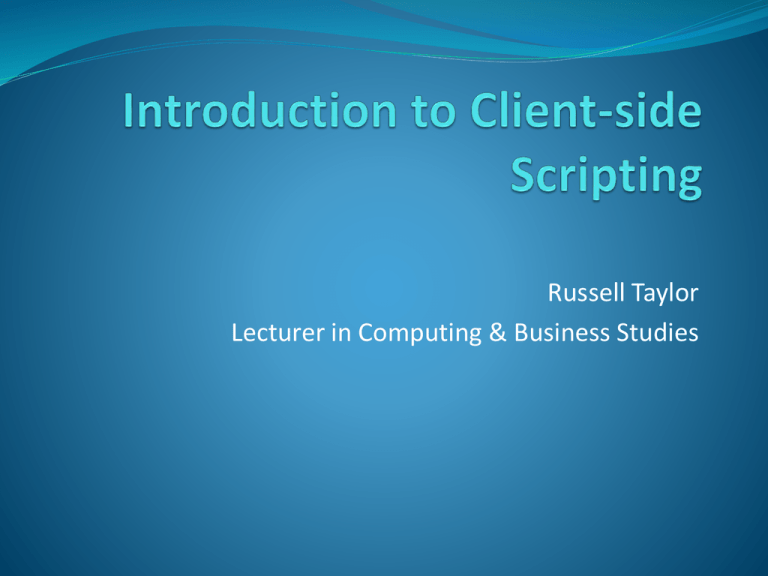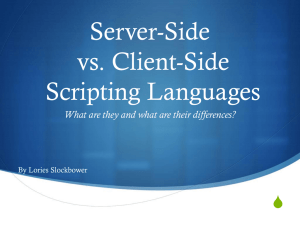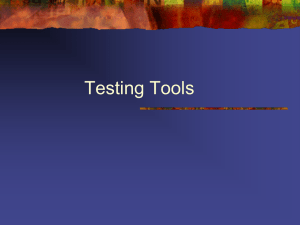Introduction to Client-side Scripting
advertisement

Russell Taylor Lecturer in Computing & Business Studies What is the Client-side Scripting Unit about? This course is a 12 Unit SQA HNC course. Units can be a single (1) or 2-Credit Unit Client-side scripting is a 2 Credit Unit at SCQF Level 8 (Higher HNC level) Assessment will be done by the completion of 3 Assessment Outcomes Unit is split into three parts to match these outcomes – with each outcome taking 12 weeks to complete What is the Client-side Scripting Unit about ? - 2 This Unit is designed to introduce candidates to the fundamental concepts of programming using scripting languages. The Unit involves combining both scripts and HyperText Markup Language (HTML) or eXtensible HyperText Markup Language (XHTML) to enable the creation of dynamic client-based web pages. It is intended for candidates who already have some understanding of HTML and/or XHTML and the fundamental requirements of creating static web pages. Client-side Scripting Outcome 1 In this first Outcome: you will learn about the environment needed to create, test, run, and access client-side scripts, such as browsers, editors, graphic packages and/or as well as other utilities and tools that enable these tasks. You will also learn about various features and characteristics associated with interpreted languages, (as opposed to compiled languages), in addition to learning about the main difference(s) between client-side and web/server-side scripts. You will learn about the wide range of scripting languages available and their major advantages and disadvantages; You will be introduced to the methods by which client-side scripts can be integrated within web applications and the means of accessing such scripts. Outcome 1 in Detail This Outcome will be assessed in the form of written recorded evidence testing your knowledge and/or skills. You will need to demonstrate that you can: For client-side scripting environment (browsers and editors) create, test, run, and access client-side scripts ; browsers, editors, graphic packages Describe the characteristics of interpreted languages the features and characteristics associated with interpreted languages compared to compiled languages will include major advantages and disadvantages Identify and describe the differences between client-side and server-side scripting environment under which each type is used ; tools needed to produce and run the scripts; on-line database accessibility Outcome 1 – More Details Types of scripting languages the different types of scripting languages currently available highlighting their major advantages, disadvantages and uses Methods used to implement client-side scripts within web pages embedded coding and externally stored code Lets Look at HTML & JavaScript Link to HTML Handout Link to JavaScript Handout Client-side Scripting Environment (Browsers and Editors) History: Web began as a text-only medium-the first browsers didn't even support images within web pages. Today's websites can include a lot of features: graphics, sounds, animation, video, and occasionally useful content. Web scripting languages also known as client-side scripting languages, such as JavaScript, are one of the easiest ways to add dynamic state to a web page and to interact with users in new ways. If you know how to use HTML (Hypertext Markup Language) to create a web document, you've already worked with one computer language. You use HTML tags to describe how you want your document formatted, and the browser obeys your commands and shows the formatted document to the user. Browsers and Editors Because HTML is a simple text markup language, it can't respond to the user, make decisions, or automate repetitive tasks. Interactive tasks such as these require a more sophisticated language: a programming language, or a scripting language. Programming languages are complex, scripting languages are generally simpler. They have a simple syntax, can perform tasks with a minimum of commands, and are easy to learn. Web scripting languages enable you to combine scripting with HTML to create interactive web pages Scripts & Programs A movie or a play follows a script-a list of actions (or lines) for the actors to perform. A web script provides the same type of instructions for the web browser. A script can range from a single line to a full-scale application. (In either case, Scripts usually run within a browser.) Some programming languages must be compiled, or translated, into machine code before they can be executed. Client-side scripts, on the other hand, are an interpreted language: The browser executes each line of script as it comes to it. Main advantage to interpreted languages: Writing or changing a script is very simple. Changing a client-side script is as easy as changing a typical HTML document, and the change is executed as soon as you refresh the document in the browser. Scripting Languages A Scripting language is a variety of 'programming' that produces ASCII text- based scripts which are usually designed for writing small programs. Scripting languages support high level language control features: selection and iteration (syntax) Referred to as 'glue-code‘ Seen as being an enhancement of particular software packages or applications. Examples of present day scripting languages are VBScript, JavaScript, Perl, Python, TCL (Tool Command Language), etc Scripting Languages 2 Applications that provide scripting capability allows the user to extend the functionality of the application by programming a sequence of actions. E.g. Filemaker Pro(a database package) it is possible to write scripts that open and close files, copy data from records or enter a certain database mode such as browse or find. Web browsers have added scripting languages to extend the capabilities of static websites into dynamic applications, that provide more richer features to the user.






